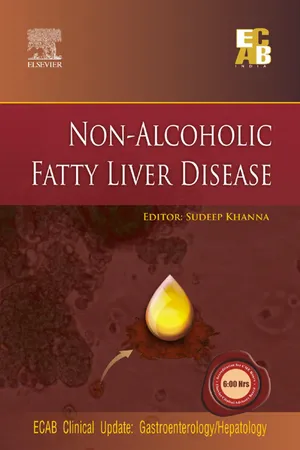
- English
- ePUB (mobile friendly)
- Available on iOS & Android
Non-Alcoholic Fatty Liver Disease - ECAB
About this book
Non-alcoholic fatty liver disease is a common cause of chronic liver disease, and its incidence is rising worldwide. Understanding its pathogenesis, biochemical parameters, histological grading and staging, and its management is a vital issue in today's clinical practice. It appears to be linked directly to the growing epidemic of obesity in adults as well as in children. Thus, in a sense, NAFLD is a self-inflicted liver disease, much like alcoholic liver disease. The exact causes responsible for the development of NAFLD have not been established yet. However, some researchers consider that cluster of disorders that increases the risk of developing heart disease, diabetes, and stroke may be the factor behind development of NAFLD.Most patients with NAFLD have no symptoms or signs of liver disease at the time of diagnosis. In these patients, abnormal liver function tests are often discovered incidentally. Non-alcoholic steatohepatitis (NASH) is that stage of the spectrum that involves fat accumulation (steatosis), inflammation (hepatitis), and scarring (fibrosis) in the liver. Those who have fatty liver or hepatic steatosis with non-specific inflammation as fatty liver with non-specific inflammation generally have a benign longterm prognosis, whereas those who have NASH can progress to cirrhosis. NASH-related cirrhosis may have similar prognosis as cirrhosis from other causes. Hepatocellular carcinoma (HCC) is part of the spectrum of NAFLD, and screening for HCC seems reasonable in patients who have NASH-related cirrhosis. No established treatment is available for NAFLD. Some empiric treatment strategies have been suggested. Presumably, weight loss through exercise and diet modification along with insulinsensitizing agents will help reverse fatty infiltration of the liver. Its incidence is reportedly on the rise the world over as well as in India. Realizing its significance, there is now greater understanding of its etiology, pathogenesis, and management. The efforts of Elsevier have been directed toward addressing these aspects.Elsevier has thus pooled its existing resources with those of the internationally acclaimed Gastroenterologists of India who have chosen to share their rich clinical knowledge, experience, and expertize to serve the practitioners and patient community.
Frequently asked questions
- Essential is ideal for learners and professionals who enjoy exploring a wide range of subjects. Access the Essential Library with 800,000+ trusted titles and best-sellers across business, personal growth, and the humanities. Includes unlimited reading time and Standard Read Aloud voice.
- Complete: Perfect for advanced learners and researchers needing full, unrestricted access. Unlock 1.4M+ books across hundreds of subjects, including academic and specialized titles. The Complete Plan also includes advanced features like Premium Read Aloud and Research Assistant.
Please note we cannot support devices running on iOS 13 and Android 7 or earlier. Learn more about using the app.
Information
Table of contents
- Cover image
- Title page
- Table of Contents
- ECAB Clinical Update: Gastroenterology/Hepatology
- Non-Alcoholic Fatty Liver Disease
- Copyright
- About the Authors
- ECAB Clinical Update Information–Non-alcoholic Fatty Liver Disease
- Clinical Profile of NAFLD in Indians
- Non-invasive Markers for Liver Fibrosis in NAFLD
- Imaging for Fat, Fibrosis, and Inflammation in Non-Alcoholic Fatty Liver Disease: Recent Developments
- Simplified Histology of Non-Alcoholic Fatty Liver Disease
- Approach to NAFLD in India
- Management of Non-Alcoholic Fatty Liver Disease and New Therapeutic Approaches
- Metabolic Syndrome in Non-Alcoholic Fatty Liver Disease
- ECAB Clinical Update: Gastroenterology/Hepatology—Other Books in This Series